
Superlux S502 ORTF Microphone Array
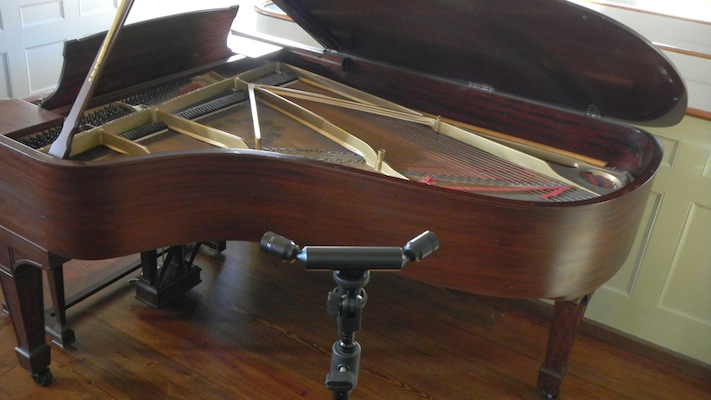 Photo © John Marks
Photo © John Marks
In my recent post about my using Sound Devices’ USBPre 2 as a location-live recording interface, I mentioned the “near-coincident” ORTF stereo microphone technique. In that case, I used an AEA stereo mic protractor ($22) to position two Pearl (Sweden) CC22 cardioid-pattern side-address microphones in the so-called ORTF array. The ORTF array is a compromise between crossed-axis “coincident” X/Y cardioid or figure-8 microphones, and “A-B” widely-spaced omnidirectional microphones. The idea is to mimic the response of the human head/ear/brain system concerning horizontal-plane stereo cues, while preserving good compatibilty to monophonic mix-down, by which I mean the avoidance of self-cancellation. Continue Reading →
Joseph Silverstein: Edward Elgar, Violin Concerto (conclusion); Boston Symphony, Colin Davis
From the Boston Symphony’s YouTube channel, here is the conclusion of the October 24, 1972 performance by Joseph Silverstein (who was then the Concertmaster of the Boston Symphony), of Edward Elgar’s Op. 61 violin concerto in B minor. The guest conductor is Colin Davis (who was knighted eight years later). By the way, at 1 minute 26 seconds, I believe I hear Colin Davis humming (or groaning) along, to bring out the big tune. (In Elgar, there’s usually a big tune.) The video runs from slightly before the (accompanied) cadenza through the end of the third, final movement.
Elgar’s violin concerto is one of the longest and most demanding violin concertos in the standard repertory. Its running time (modern recordings average circa 50 minutes) is about twice that of the most popular violin concertos (those of Mendelssohn and Tchaikovsky). In addition to the demands Elgar’s concerto makes on the soloist’s endurance, his concerto presents many technical challenges. And portions of this video give an excellent birds-eye view of Silverstein’s rising to meet those violinistic demands.
Although Elgar’s rhapsodic style here, which is both discursive and intensely emotional, might take a bit of getting used to, I find that through the years, Elgar’s has always been one of my favorite violin concertos. And, as you will see as you read on past the jump link, I agree with my friend Bob Ludwig: that with Elgar, the interpretation makes the performance—this is not music that “plays itself.” Continue Reading →
Sound Devices USBPre 2 as a Location-Live Recording Interface
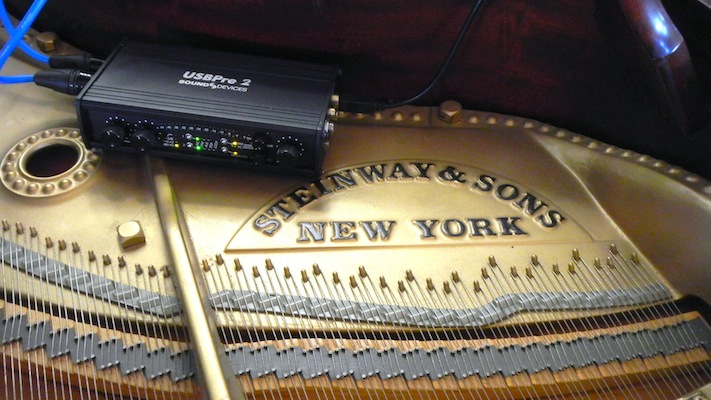
As part of my series on making digital transfers of vinyl LP phono records, I recommended Sound Devices’ USBPre 2 (street price $895) as the most cost-effective (“Pareto Optimal”) USB combination analog-to-digital converter and monitor (headphones or loudspeakers) controller. In that usage, the USBPre 2 takes an analog output from a phono stage through its line-level RCA jacks and converts the analog signal to digital (at data densities up to 24 bits/192kHz), and outputs the digital datastream via USB cable to a host computer (which is also the source of the USBPre 2’s power). The linked-to blog post enumerates the USBPre 2’s many virtues, and makes a compelling case for its value for money.
In addition to digitizing LPs, the USBPre 2 can be used for live recording. The USBPre 2 can provide 48V “phantom” power to professional microphones (but the 48V power can be switched off for pure-ribbon or dynamic microphones). Further, the USBPre 2’s metering and monitoring are truly professional-class. Given that the USBPre 2’s microphone preamplifiers are based on those of Sound Devices’ industry-standard 700 Series remote-location portable digital recorders, I wanted to make a location-live solo-piano recording. More details, and a sound sample, after the jump. Continue Reading →
In Memory of Richard Shahinian, 1931 – 2017
In memory of music lover and loudspeaker designer Richard “Dick” Shahinian, I offer a very impressive live performance of Mozart’s Requiem, by the French vocal ensemble Arsys Bourgogne with the Camerata Salzburg. Aside from faith and family, Dick’s major passion in life was large-scale orchestral music (or large-scale works for orchestra and chorus). The larger the scale, the better, it seemed. During one audio show, I asked Dick to play on his demo system a track I had brought with me, a live recording of Jessye Norman singing the Angel’s Farewell from Elgar’s The Dream of Gerontius. After the track had played, Dick allowed that it was all fine and good; but then he asked me why had I not played the Demons’ Chorus, instead? That’s Dick in a nutshell—unusually knowledgeable about even the most obscure musical works, and… very opinionated.
Dick’s love affair with classical music began at age 14, with the birthday present of a 78-rpm phonograph and a recording of Gershwin’s Rhapsody in Blue. About a year later (1946), at Carnegie Hall, Dick heard the New York Philharmonic play Richard Strauss’ Metamorphosen and Bruckner’s Eighth Symphony, conducted by Bruno Walter. Years later, Dick wrote, “I have never quite recovered from the shattering impact of that experience.”
After serving honorably in the United States Marine Corps, from the late 1950s on (the blossoming of the Golden Age of Hi-Fi), Dick devoted his career to bringing the thrill of live orchestral music into peoples’ homes (to the greatest extent possible, that is) by advancing the art of loudspeaker design. For more, please click on the jump link. Continue Reading →
In Memory of Charles Hansen, 1956-2017
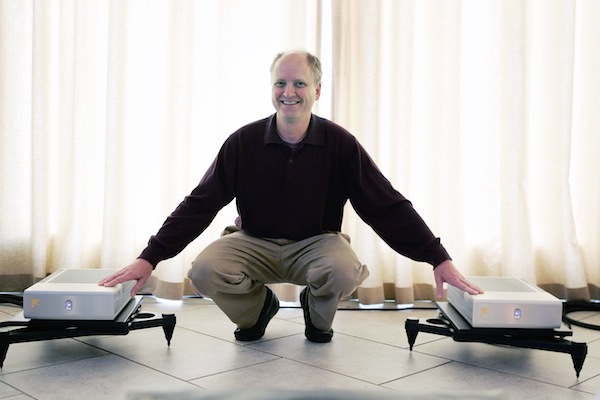
Audiac Persdag 26-04-2006
Foto en © Jiri Büller
The small world of high-end audio is reeling from the untimely and unexpected death of Charles Hansen, who was the chief designer of Avalon Loudspeakers before striking out on his own to found Ayre Acoustics. Ayre Acoustics’ announcement concludes with the request that those who remember him, at some time over the coming holidays, play an album in memory of Charley. I am sure that I will do that.
As a reviewer for Stereophile magazine and then as a consultant for the University of the South’s Ralston Listening Library (the audio system of which, in its first incarnation, included Ayre amplifiers driving Wilson Audio’s Alexandria II loudspeakers), I got to know Charley, and to appreciate his passion for musical truth, and truth in general.
Charley Hansen was a good man and a devoted father. He had a vibrant interest in education of all kinds, but especially music education. If I recall correctly, he was a supporter of Waldorf education, and I know he was very proud of his child the student violinist. After an irresponsible person nearly ended but surely blighted Charley’s life, I always continued to marvel at his equanamity and grace.
I will miss him.
I know that Charley loved violin music, because he once asked me to send him some JMR CDs by Arturo Delmoni, and then he insisted on paying for them.
So, in memory of Charley, I offer my music video “Wally the Finch Listens to Hlif Sigurjonsdottir Play Bach.”
# # #
Chamber Choir of Europe, Nicol Matt: Lauridsen “Sure On This Shining Night” Making-Of
James Agee (1909-1955) had a difficult and comparatively brief life. Born in Knoxville, Tennessee, his life was upended at age six when his father was killed in an automobile accident. Thereafter, Agee and his younger sister Emma were sent off to various boarding schools. Agee was a member of the class of 1932 at Harvard. Upon graduation, he went to work for Time, Inc.’s magazine Fortune. In 1934, he published his only volume of poetry, Permit Me Voyage.
In 1938 Agee wrote a brief prose piece, “Knoxville, Summer of 1915” that Samuel Barber later (1948) set for soprano and orchestra. In 1938, Barber had set another Agee text, “Sure On This Shining Night,” a brief untitled poetic fragment from Permit Me Voyage. Barber’s “Shining Night” setting is solidly in the core or standard repertory, both in its solo-voice and choral versions. More recently (2005), composer Morten Lauridsen’s choral setting of “Sure On This Shining Night” has earned worldwide currency for its soulful treatment of Agee’s enigmatic, pensive, yet I think ultimately hopeful lines.
Agee later participated in the writing of two of the most famous films of the era, The African Queen and Night of the Hunter. He was posthumously awarded the Pulitzer Prize in 1958 for his autobiographical novel A Death In the Family. Agee’s reputation as a writer is usually thought to rest upon A Death In the Family and his Depression-era journal Let Us Now Praise Famous Men. But it cannot be doubted that Agee was one of the most important English-language art-music lyricists of the 20th century. That is, as long as one judges by quality, and not merely quantity.
Text, commentary, and a news flash, all after the jump. Continue Reading →
Adam Schoenberg: “Finding Rothko” and other orchestral works
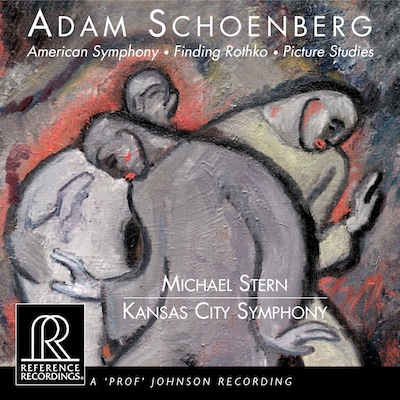
Adam Schoenberg: Finding Rothko, American Symphony, and Picture Studies.
Kansas City Symphony, Michael Stern, conductor.
Reference Recordings RR-139 Hybrid+MCH SACD and Downloads
David Frost, producer; Keith O. Johnson, engineer and mastering engineer.
My recent entry on the Morton Feldman musical work inspired by Houston’s Rothko Chapel noted that Rothko’s huge canvasses displayed there had also inspired Peter Gabriel’s song “Fourteen Paintings.” Four different Mark Rothko paintings that span the years 1949 to 1959 more recently inspired American composer Adam Schoenberg (b.1980) to write Finding Rothko, an orchestral work in four movements identified by the colors Orange, Yellow, Red, and Wine. Finding Rothko is concise, tonal, melodic, and accessible, with brilliant orchestration.
The obvious parallel is to Arthur Bliss’ A Colour Symphony of 1922 (which perhaps was an un-acknowledged inspiration). A Colour Symphony‘s movements are also named after colors; in Bliss’ case, the heraldic colors Purple, Red, Blue, and Green.
More ponderings and generous sound samples after the jump. Continue Reading →
SWR Vokalensemble, Marcus Creed: Morton Feldman, “Rothko Chapel”
Morton Feldman’s Rothko Chapel is scored for solo viola, solo alto voice, solo soprano voice, mixed chorus, and celesta; with percussion consisting of bass drum, chimes, gong, temple block, tenor drum, timpani, vibraphone, and wood block. Feldman (1926-1987) composed Rothko Chapel in 1971, specifically for the building of that name, in Houston, Texas, which was a gift to the public from the Ménil Foundation. The Rothko Chapel (Wiki) (Home Page) was designed to house and display 14 huge canvases the Ménil Foundation commissioned from the American Abstract Expressionist painter Mark Rothko (1903-1970).
My personal opinion is that Feldman’s Rothko Chapel is one of the most magically organic pieces of modern music. But I can also easily envision the possible so-so (or negative) reactions, that the music was meant be the soundtrack to an aromatherapy session, or that the paintings are what happens when a depressive can only afford half-empty cans of house paint, in the dullest possible hues.
Both Rothko and Feldman declined to embrace the prevailing or at least most talked-about artistic trends—of self-conscious Modernism (such as Pop Art) in painting, and of 12-tone academic serialism in music. Even so, the challenging (or, numinous) nature of Rothko’s paintings and of the music they inspired does force one to confront the question whether some mid-20th-century art was only “the Emperor’s New Clothes.” More after the jump. Continue Reading →
A Pair of Bose 901s in a 21st-Century California Home
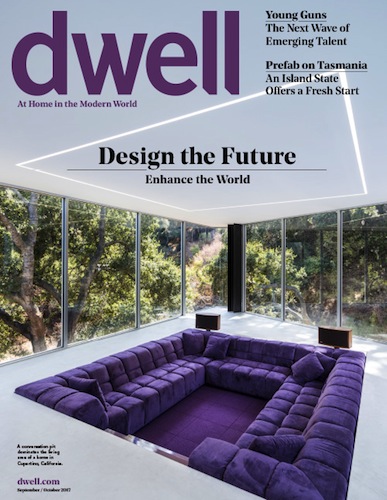
It took me a moment to realize that the loudspeakers behind the conversation pit of the 21st-century California home that is the subject of the cover story of the September/October issue of Dwell magazine were venerable Bose 901s.
I not only bought the issue; I took out a subscription.
Dwell‘s cover-story house (Craig Steely, architect) will not appear on the cover of This Old House, at least any time soon. (Give it 100 years.) Very cutting-edge in its details, such as the curved corners of the glass walls and the LED ceiling strip lights that set off different areas, the house nonetheless adheres firmly to the Mid-Century-Modern precept of siting the home within nature, rather than in opposition to it. The first similar design was Mies van der Rohe‘s see-though glass-walled Farnsworth House, built for Dr. Edith Farnsworth.
OK… But–how did the 901s get into a 21st-century house?
For that, some background on the 901, and my thoughts about the architectural-acoustical aspects of the design, please click the jump link. Continue Reading →
Frederica von Stade: Canteloube, Songs of the Auvergne, Album I
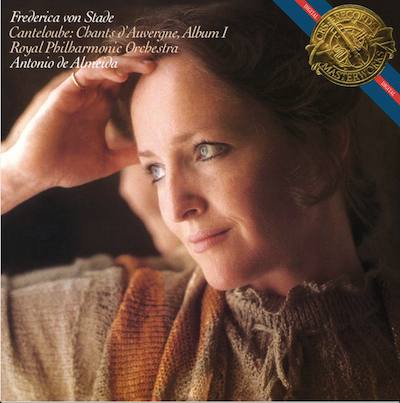
Frederica von Stade: Canteloube, Songs of the Auvergne, Album I (1982)
CD CBS MK 37299 (o.o.p.) and Sony Essential Classics CD 63063
(also o.o.p.; but available as just-in-time replicated from Arkivmusic)
Frederica von Stade, mezzo-soprano; the Royal Philharmonic Orchestra, Antonio de Almeida, conductor. David Mottley, producer; Peter Brown, engineer.
I treasure the wonderful folk-song orchestrations on this recording so much; I have, since it first came out on LP. However, its comparative obscurity today tempts me to think that my enthusiasm for a recording really is The Kiss of Death. This recording is Out of Print from Sony? Are you kidding me?
At least Clifford Brown With Strings and Sleeping Gypsy are still in print. Sigh.
Frederica von Stade signed up at New York’s Mannes School of Music as a part-time student in order to learn how to read sheet music—but only for her own enjoyment. Some faculty members recognized her potential, and urged her to apply for full-time status. In less time than it takes to earn an undergraduate degree, she had learned enough about singing and the repertory to audition for the Metropolitan Opera. The Metropolitan Opera immediately offered her a three-year contract; the rest, as they say, is history (a history that includes more than 75 major-label recordings).
(Despite the above’s having “the additional benefit of being the truth,” I think that if somebody were to write that story into a movie script, people would say, “Yeah, right. Get serious!”)
More info, and sound bytes, after the jump. This is a touchstone CD that is well worth the effort to find. Just find it and BUY IT! Continue Reading →


